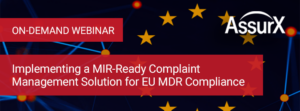November 29, 2022
The shortage of notified bodies (NB) in the European Union is a key challenge for device manufacturers struggling with Medical Device Regulation (MDR) compliance. As a result, the EU’s Medical Device Coordination Group (MDCG) is encouraging the use of hybrid audits.
MDR, which took effect in May 2021, defines the rules for the sale of medical devices in the EU. It requires all devices in the EU market to be resubmitted for compliance. As a result, products that were compliant under the Medical Device Directive (MDD) may not meet the requirements for MDR compliance.
About 1,000 MDR certificates have already been issued as of June 2022, according to the European Commission. However, more than 24,000 devices with certificates issued under MDD will expire in May 2023.
EU countries are concerned about the possible disruption of the supply of those devices if they aren’t certified on time. In response, the MDCG, composed of representatives of member states, issued recommendations to facilitate MDR compliance in August 2022.
“The MDCG advises notified bodies to make use of hybrid audits where they consider that this would contribute to conducting the conformity assessment in a timely and efficient manner in compliance with the regulations,” according to the MDCG position paper.
Hybrid Audits Versus Remote Audits
What are hybrid audits? How are they different from remote audits? BSI, a notified body in the UK and EU, explains that a hybrid audit uses a technology-driven off-site audit with an on-site audit conducted by at least one auditor. Similarly, the FDA uses a hybrid audit approach, combining remote regulatory assessments (RRA) with on-site inspection and other regulatory tools.
A remote audit means the entire process is conducted virtually. An auditor conducts it through live web-streaming technology such as Zoom, WebEx, or Microsoft Teams, according to BSI. The auditor may work from either a BSI office or the auditor’s home. In addition, the auditor may also conduct a remote audit from a manufacturer’s facilities.
The MDCG acknowledged that the lack of NBs creates “significant and urgent challenges” for medical device and in-vitro device manufacturers.
Additional Recommendations
In addition to using the hybrid audit, the group made other recommendations to increase the capacity of the notified bodies. These include:
- NBs should leverage evidence from previous product audits to avoid unnecessary duplication of work.
- Expanding training and coaching to foster capacity-building of existing and potential new notified bodies.
- NBs should streamline internal administrative procedures. In the meantime, the MDCG will review its guidance to potentially eliminate undue documentation scope to reduce administrative workload.
- Flexibility must be applied in reviewing legacy devices that are considered effective and safe. For example, previous guidance (MDCG 2022-4) encourages combining audits under MDD and MDR for legacy devices under NB review.
What You Need to Leverage Hybrid Audits
Companies need the right technology for hybrid audits. Therefore, manufacturers using a paper-based quality management system (QMS) for MDR compliance will find hybrid audits nearly impossible. In practice, a company should aim for having the capabilities for both hybrid and remote audits. For both types of audits, an enterprise quality management system (EQMS) is a prerequisite.
An EQMS can help you optimize hybrid audits for MDR compliance and other regulatory requirements. Here’s how:
A Centralized Platform for a Single Source of Truth
An EQMS provides a centralized platform for managing all MDR-related quality documents and tasks. It enables the NB to find everything it needs in one place. The EQMS provides a secure virtual workspace for the audit and allows users to efficiently prepare for the audit. In addition, a digital EQMS can be integrated with other best-in-breed systems to pull in related enterprise data.
Streamlined Document Management
Document management is the foundation of MDR compliance efforts. Therefore, every process that impacts product quality and safety must be properly documented. Furthermore, automating all document-centric tasks and processes increases efficiency in routing, revision, escalation, and approvals.
Integrated Risk Management
Throughout the product lifecycle, demonstrating risk management is key to MDR compliance. Under MDR (Article 10), manufacturers are required to maintain a risk management system. Proof of device safety and performance are necessary, and the higher the device risk, the more extensive the scrutiny will be. An EQMS can incorporate risk management in all critical processes to identify and mitigate risks throughout the device lifecycle. A robust system includes Failure Modes and Effects Analysis (FMEA), risk scoring, risk prioritization, and other tools.
A Closed-Loop Platform
A closed-loop EQMS connects all quality processes that affect device safety, which are likely to be part of inspection during hybrid audits. It connects with document management, training, CAPA, and other critical processes for unified compliance insights. In addition, platform connectivity also enables demonstrable, proactive monitoring of quality trends – something auditors will be looking for. Furthermore, those trends may indicate quality issues which can immediately launch tasks for investigation and CAPA.
A Training Management Process
For medical device manufacturers, proper training can help prevent quality problems, while poor training can contribute to them. Obviously, that is why auditors are likely to go over employee training records.
In a manual system, managing an individual employee’s training file requires extensive time and effort. Misplaced and incomplete records can create issues during an audit. A fully automated training management process provides one-click access to an employee’s training file. Furthermore, training status is trackable, and late training can be escalated to ensure timely completion. During hybrid audits, the auditor can readily inspect all training records in a centralized repository.
Increased Transparency
A manual system relies on paper documents, forms, and spreadsheets that lack the visibility you need in hybrid audits. Alternatively, an EQMS makes quality processes transparent through dashboards, drill-down reports, and other real-time metrics. It provides visibility into the quality lifecycle within one system.
Increased Adaptability for Continued Success
Hybrid audits are necessary due to a lack of NBs. However, the benefits extend beyond MDR/IVDR. When a disruption occurs, (e.g., COVID-19), an EQMS facilitates the ability to work and conduct audits remotely. It gives manufacturers the capability to interact with users, auditors, and stakeholders, regardless of geographic location. As a result, there is no user downtime, which further demonstrates quality management efficiency.
Conclusion
In summary, medical device firms are anxious about the impact of NB scarcity on their MDR compliance. As of October 2022, there are only 31 notified bodies, according to the European Association for Medical Device Notified Bodies. Justifiably, EU member states are concerned that bottlenecks in MDR and IVDR certifications could disrupt device availability and profitability.
Unfortunately, there is not much that a device manufacturer can do about the lack of NBs. However, acquiring the capability to conduct or participate in hybrid audits is one of the best ways you can help prepare. Furthermore, being remote audit ready is one step towards demonstrating compliance in the long haul. A fully automated and integrated EQMS will increase your ability to adapt, as well as drive other quality improvements throughout the organization.
About the Author
Stephanie Ojeda is Director of Product Management for the Life Sciences industry at AssurX. Stephanie brings more than 15 years of leading quality assurance functions in a variety of industries, including pharmaceutical, biotech, medical device, food & beverage, and manufacturing.
Related Reading:
EU Medical Device Regulation Still Presents Challenges and Opportunities



